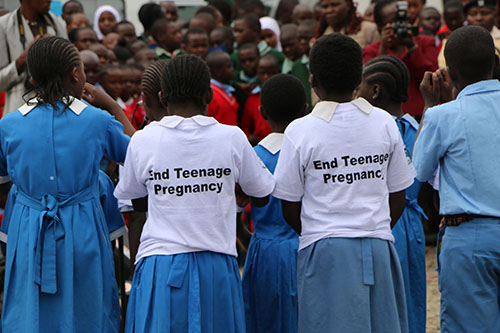Editorial Column
Adolescent Pregnancy In Africa, Causes And Prevention

Adolescence is the period between 10 and 19 years with peculiar physical, social, psychological and reproductive health characteristics.
Rates of adolescent pregnancy are increasing in developing countries, with higher occurrences of adverse maternal and perinatal outcomes.
The few studies conducted on adolescent pregnancy in Africa present inconsistent and inconclusive findings on the distribution of the problems.
Also, there was no meta-analysis study conducted in this area in Africa. Therefore, this systematic review and meta-analysis were conducted to estimate the prevalence and sociodemographic determinant factors of adolescent pregnancy using the available published and unpublished studies carried out in African countries.

Adolescent pregnancy
Also, subgroup analysis was conducted by different demographic, geopolitical and administrative regions.
This review included 52 studies, 254,350 study participants. A total of 24 countries from East, West, Central, North and Southern African sub-regions were included.
The overall pooled prevalence of adolescent pregnancy in Africa was 18.8% (95%CI: 16.7, 20.9) and 19.3% (95%CI, 16.9, 21.6) in the Sub-Saharan African region.
The prevalence was highest in East Africa (21.5%) and lowest in Northern Africa (9.2%). Factors associated with adolescent pregnancy include rural residence (OR: 2.04), ever married (OR: 20.67), not attending school (OR: 2.49), no maternal education (OR: 1.88), no father’s education (OR: 1.65), and lack of parent to adolescent communication on sexual and reproductive health (SRH) issues (OR: 2.88).
Overall, nearly one-fifth of adolescents become pregnant in Africa. Several sociodemographic factors like residence, marital status, educational status of adolescents, their mother’s and father’s, and parent to adolescent SRH communication were associated with adolescent pregnancy. Interventions that target these factors are important in reducing adolescent pregnancy.

Adolescent pregnancy
Adolescent pregnancy has become a major public health problem, particularly in Africa. Consequently, the region is known for the high rate of maternal and child morbidity and mortality.
Since recent times, several governmental and non-governmental organization in some African countries focused on reducing the adolescent pregnancy rate, although a very slow progress was made.
Several published and unpublished studies conducted on the prevalence of adolescent pregnancy in Africa are available.
However, these studies present inconsistent and inconclusive findings and little is known about the overall epidemiology of adolescent pregnancy in the continent.
This study, therefore, was conducted to estimate the prevalence and sociodemographic factors associated with adolescent pregnancy in Africa using published and unpublished studies. This study included a total of 52 studies from 24 African countries.
Accordingly, almost one-fifth (18.8%) adolescent get pregnant in Africa. A higher prevalence was observed in East African sub-region (21.5%).
Adolescents from rural areas, ever married, whose mother or father were not educated, and had no parent to child communication on SRH issues were more likely to start childbearing at a younger age.
Read Also: Wet Dreams Not A Disease Or Spiritual Attack —Physician
Therefore, African countries and other non-governmental organizations need to address these factors and the multifaceted sexual and reproductive health needs of adolescents.
Programs aimed at improving the contraceptive use, prevention of unintended pregnancy, prevention of early marriage and risk behavior reduction can reduce the high rate of adolescent pregnancy in Africa.
Background
Globally, around 1 in 6 people are adolescents aged 10 to 19 years old .
Adolescent pregnancy is defined as the occurrence of pregnancy in girls aged 10–19.
Almost one-tenth of all births are to women below 20 years old, and more than 90% of such births occur in developing countries.
The declining age at menarche and better nutrition and healthier lifestyles of younger generations are the main factors for high rate of adolescent pregnancy globally.
World Health Organization (WHO) 2014 report showed that the global adolescent birth rate was 49 per 1000 girls aged 15 to 19 years old.
Adolescent pregnancy is a major public health problem, particularly in Africa [6]. It is associated with high maternal and child morbidity and mortality and affects the socio-economic development of a country.
It is linked to an increased risk of adverse pregnancy and childbirth outcomes compared to older women. More than 70,000 adolescent girls die every year because of these complications mainly in developing countries.
Most maternal and child morbidity and mortality are related to hypertensive disorders of pregnancy, infections, low birth weight, and preterm delivery.
Pregnancy among adolescent women has implications on the educational opportunity, population growth and ill-health of women. For this reason, prevention of child marriage and reduction of adolescent pregnancy has long been the focus of attention by several governmental and non-governmental organizations.
Moreover, the reduction in the adolescent pregnancy birth rate since 1990 has resulted in the decline of maternal mortality rate among teenagers especially in developed nations. Several studies have shown that the high level of maternal and perinatal morbidity and mortality can be reduced by lowering the high rate of adolescent pregnancy in developing countries.
Consequently, reducing the high rate of adolescent pregnancy and maternal mortality is considered as the key Sustainable Development Goals (SDG),target 3.1 and 3.7.
Even though the identification of the distribution of adolescent pregnancy is important in designing proper interventions to reduce the problem, the small sample sizes and a limited number of available studies were the challenges in identifying the magnitude of the problem in Africa.
There is also the absence of the distribution of the problem in different geopolitical and administrative areas.
Additionally, the available studies which assessed the factors associated with adolescent pregnancy in Africa showed inconsistent findings.
Therefore, this review used the evidence of these studies and summarized the pooled estimates using a meta-analysis.
There was one previous systematic review [26] conducted to assess the determinants of adolescent pregnancy in Sub-Saharan African countries. However, it included the sociocultural, economic and environmental factors which affect adolescent pregnancy, and didn’t use meta-analysis methods to pool the prevalence and determinants of adolescent pregnancy.
The current study, therefore, used both systematic and meta-analysis methods to estimate the pooled prevalence and sociodemographic determinants of adolescent pregnancy in Africa.
This study further examined the prevalence of adolescent pregnancy by different study characteristics like sub-regions of Africa, study design and type, publication year, and study quality score.
The findings of this study will help to design strategies aimed at reducing adolescent pregnancy and monitor the progress of programs aimed at achieving the adolescent pregnancy rate and maternal mortality reduction targets of SDG.
Several sociodemographic related factors which affect adolescent pregnancy were included. These factors include residence (rural vs urban), marital status (ever married vs never married), educational status of an adolescent girl (not attended vs attended), educational status of mother (not attended vs attended) and educational status of the father (not attended and attended).
Adolescent girls who were currently married or divorced or previously married or living together were categorized as ever married.
Also, for the educational status of adolescents and their family, primary, secondary or tertiary educational levels were grouped as attended and those who have never been admitted to school were grouped as not attended.
In addition, parent to adolescent communication on sexual and reproductive health (SRH) issues was also included.
Advertise or Publish a Story on EkoHot Blog:
Kindly contact us at [email protected]. Breaking stories should be sent to the above email and substantiated with pictorial evidence.
Citizen journalists will receive a token as data incentive.
Call or Whatsapp: 0803 561 7233, 0703 414 5611






